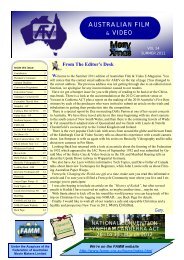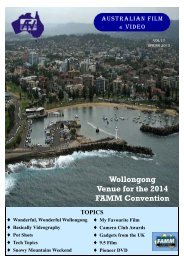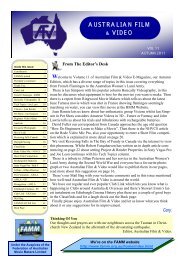20 AFV Winter 2013.pub - Federation of Australian Movie Makers
20 AFV Winter 2013.pub - Federation of Australian Movie Makers
20 AFV Winter 2013.pub - Federation of Australian Movie Makers
Create successful ePaper yourself
Turn your PDF publications into a flip-book with our unique Google optimized e-Paper software.
BASICALLYVIDEOGRAPHYby Ian SimpsonThe Frustrations <strong>of</strong> the Amateur VideographerIn this hobby <strong>of</strong> movie making have you ever created a video that you thought, at the time, was really good only t<strong>of</strong>ind that your teenage children or grand children ridicule it, or that in your club competition, the judges mark itdown? I have. Aside from the disappointment, there is the realisation that either your technical standards or yourcreativity or both are not up to that <strong>of</strong> your peers. This realisation can come to you as a shock after a poor performancein a competition or it can come to you, as it did to me, over a period <strong>of</strong> time. In my case, for years I reconciledmy poor performance in competitions as being a consequence <strong>of</strong> the genre <strong>of</strong> videos I like to make; documentaries.I rationalised that comedies, animations and dramas, if well made, would always beat a well made documentary. Ifooled myself for years with the argument that audiences like to be entertained first and informed second. This selfdeception can go on until something pierces this deception balloon. In my case it was an article in the electronicmagazine f11 Magazine. This is a web based monthly magazine that originates from New Zealand for the still photographers.One article in the September <strong>20</strong>12 issue caught my eye. It was by Tony Bridge and it was entitled,Clarity and Megapixels. http://issuu.com/f11magazine/docs/issue14-september<strong>20</strong>12?mode=window&backgroundColor=%23222222In this article Tony began with a similar question to the one I posed above; why, with the same equipment, couldn’the produce the same startling images as a fellow photographer? His answer to this question was that he did nothave the same “clarity <strong>of</strong> vision” as the other photographer. Tony then went on to say what was NOT clarity <strong>of</strong>vision but he wasn’t too clear on what was clarity <strong>of</strong> vision. Translating his concept <strong>of</strong> what is not clarity <strong>of</strong> visioninto the moving image domain, clarity is not the content <strong>of</strong> the video; nor is it the freshness or originality <strong>of</strong> themovie; nor is it its use <strong>of</strong> special effects, nor the slickness <strong>of</strong> editing; nor how well integrated the sound track; noris it the quality <strong>of</strong> the images; nor the power <strong>of</strong> the non-linear editing s<strong>of</strong>tware; nor even the number <strong>of</strong> awards themovie may have won in competitions. For Tony clarity <strong>of</strong> vision is when the photographer captures an image that“resonates” with the viewer; where the image creates an emotional experience in the viewer. All <strong>of</strong> this is very subjective;evoking emotions, spiritual resonating, speaking to the inner soul, communicating to the individual “clearlyand honestly.” Can there be no quantification <strong>of</strong> this subjectivity?Does Clarity <strong>of</strong> Vision mean Unity <strong>of</strong> Content and Form?We, like our still photography brethren, <strong>of</strong>ten approach the hobby <strong>of</strong> photography and movie making from thewrong end. Encouraged by advertisements, we blindly hope that good movies will come from the best equipmentor the latest editing program or the best collection <strong>of</strong> special effects. We subconsciously hope that good equipmentwill make up for our poor creativity. But deep down we know they won’t and the results <strong>of</strong> each competition confirmthis. Ralph Hattersley in an article in Popular Photography many decades ago used the analogy <strong>of</strong> whatmakes us human to try to explain how a good photographis achieved or in our case how a good movie ismade. He said that although you may have all theparts that make a human being it is only when you putthem together in the correct way than you have a person.Thus for Hattersley, a great picture happens whenform (the correct ‘composition’ <strong>of</strong> the human body) isperfectly matched with the content (the parts <strong>of</strong> thehuman body). When this perfect matching <strong>of</strong> form andcontent occurs then according the Hattersley you have“unity.” So perhaps this “unity” <strong>of</strong> Hattersley is thesame as Bridge’s “clarity <strong>of</strong> vision”? The graph onthe right presents this idea diagrammatically.For us videographers form is what is assessed in most club movie judging sheets with the final video mark <strong>of</strong>tenthe sum <strong>of</strong> these form categories. So what are these form categories? Well they can be camerawork, effective use <strong>of</strong>sound, editing and titles. The content <strong>of</strong> the video, however, rarely gets attention. Whilst the successful mixing <strong>of</strong>form and content elements in a movie to achieve unity is never assessed or quantified. However, it is this unity thatgives meaning to a movie. It is what makes us viewers say, “now that was a great movie!”Page <strong>20</strong> AUSTRALIAN FILM & VIDEO—VOL <strong>20</strong> WINTER <strong>20</strong>13










